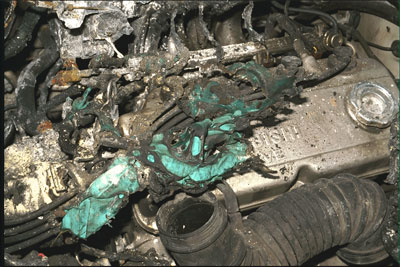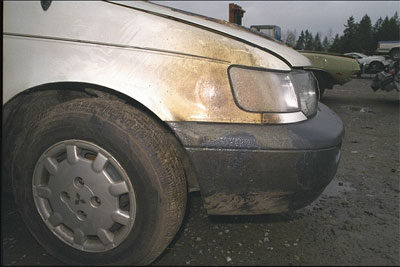|
|
Mitsubishi Expo LRV: Case Study
Fuels and Ignition
Fuels: This vehicle was stolen and reported to have been subject to engine compartment fire damage during the two days it was missing. It was clear by the absence of impact damage that this was a non-collision fire. Gasoline was the only liquid fuel system breached during the fire. Although the engine could not be started to confirm it, there was no other liquid fuel leakage evident. The only gasoline line breached was the hose between the filter and fuel rail. The damage evident may have been due to heat (post-fire) or from leakage leading to the fire. The brake fluid reservoir was also in the region of heat damage; however, fluid was still present in the reservoir. It was considered a less likely source of originating fuel; the lines to the master cylinder were not disturbed, the reservoir itself was not pressurized, and the reservoir was rearward and outboard of the region of predominant heat damage. There were electrical wires with heat damage as well, but all appeared to have been subject to external heating.
The possibility of arson was also considered. A heavily burn-damaged piece of nylon cloth-like material was found on the right rear of the valve cover. This material was reasonably central to the heat damage. In addition to the fire in the engine compartment, the right-front fender and adjacent bumper also showed scorching from heat. This region was not directly associated with other areas of burn damage. Other combustibles located between the right-front fender and engine fire did not demonstrate evidence of burn damage. It was considered possible that, during an arson attempt, gasoline or other accelerants were poured in the rear right of the engine compartment. If accelerants were spilled on the right-front fender the burn damage observed would be possible.
 Scorched green fabric material, previously located behind valve cover was moved to top of valve cover for a photograph |
 Scorched right front fender and bumper, showing evidence of external heat, likely from liquid accelerant burning on the surface. This area was not contiguous with other areas of heat damage on hood. |
Ignition: No physical evidence of ignition was found in the engine compartment. The shielded exhaust manifold was in front of the engine and lacked evidence of scorching or fire damage. Sparking from normally operating electrical devices or shorting of wires later disturbed by fire could not be ruled out. No evidence of pre-fire electrical system malfunction was identified. Matches, a butane lighter and cigarette butts were found inside the vehicle and may have been involved in arson.
|
|
|